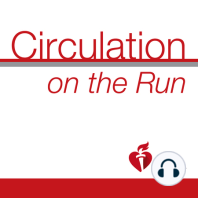17 min listen
Circulation January 24, 2017 Issue
ratings:
Length:
17 minutes
Released:
Jan 23, 2017
Format:
Podcast episode
Description
Dr Carolyn Lam: Welcome to Circulation on the Run, your weekly podcast summary and backstage pass to the journal and its editors. I'm Dr. Carolyn Lam, associate editor from the National Heart Centre and Duke-National University of Singapore. In just a moment, we're going to be discussing new results of the pioneer trial, and the patient with atrial fibrillation who undergoes intracoronary stenting, a familiar conundrum. What's the role of NOACs? Is there still a role for full-dose triple therapy with warfarin? First, here's your summary of this week's journal. The first paper tells us about the clinical impact of left atrial appendage closure. Dr. Melduni and colleagues from the Mayo Clinic in Rochester, Minnesota, studied 9,792 patients undergoing bypass or valve surgery between 2000 and 2005. They used propensity score matching to estimate the association of left atrial appendage closure with early post-operative atrial fibrillation- defined as atrial fibrillation within 30 days of surgery- ischemic stroke, and mortality. They found that after adjustment for treatment allocation bias, left atrial appendage closure during routine cardiac surgery was significantly associated with an increased risk of early post-operative atrial fibrillation, and did not influence the risk of stroke or mortality. They therefore concluded that it remains uncertain whether prophylactic exclusion of the left atrial appendage is warranted for stroke prevention during non-atrial-fibrillation-related cardiac surgery. The next study provides pre-clinical evidence that genes on sex chromosomes may contribute to the sexual dimorphism of abdominal aortic aneurysms. That is, we well know that abdominal aortic aneurysm is a male-predominant disease. Now, in this paper, by first author Dr. Alsiraj, corresponding author Dr. Cassis and colleagues from the University of Kentucky, female LDL-receptor-deficient mice, with an XX or XY sex chromosome complement, were infused with angiotensin II for 28 days to induce abdominal aortic aneurysms. DNA microarrays were performed on the abdominal aortas, and to mimic the males, the female mice were administered a single dose of testosterone. They found that an XY sex chromosome complement, in phenotypic females, profoundly influenced aortic gene expression profiles and promoted abdominal aortic aneurysm severity. When XY females were exposed to testosterone, aneurysm rupture rates were striking. The mechanisms for augmented abdominal aortic aneurysm severity in XY females included increased inflammation, augmented matrix metalloproteinases, and oxidative stress. These results, therefore, demonstrate that genes on the sex chromosomes regulate aortic vascular biology and contribute to sexual dimorphism of aortic abdominal aneurysms. Sex chromosome genes may therefore serve as novel targets for sex-specific abdominal aortic aneurysm therapeutics. The next two studies shed light on the mechanism of action of PCSK9 monoclonal antibodies on lipoprotein metabolism. In the first study, Dr. Watts and colleagues from University of Western Australia carried out a two-by-two factorial trial, of high-dose atorvastatin versus evolocumab on stable isotope tracer kinetics in 81 healthy, normal lipidemic, non-obese men. They found that both atorvastatin and evolocumab independently accelerated the fractional catabolism of VLDL apoB, IDL apoB, and LDL apoB. On the other hand, evolocumab, but not atorvastatin, also decreased the production rate of IDL apoB and LDL apoB. The reduction of LDL apoB and LDL cholesterol was significantly greater with a combination versus either mono-therapy. In summary, they found that in healthy, normal lipidemic men, evolocumab decreased the concentration of atherogenic lipoproteins, particularly LDL, by accelerating their catabolism, and by reducing IDL and LDL production. The latter effects are incremental to statins. The second paper to deal with this topic comes from Dr. Ginsberg and col
Released:
Jan 23, 2017
Format:
Podcast episode
Titles in the series (100)
Circulation January 24, 2017 Issue: Circulation Weekly: Your Weekly Summary & Backstage Pass To The Journal by Circulation on the Run
